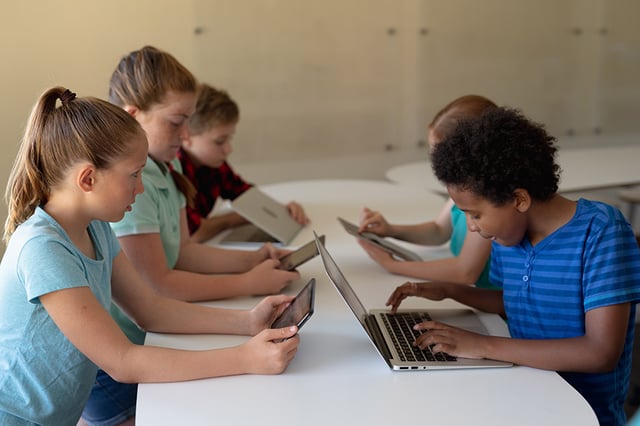What We Learned from Analyzing Tech Integration Models
 Insights By Anna McVeigh-Murphy
Insights By Anna McVeigh-Murphy
**This article is an excerpt from our whitepaper, The Tech Coach's Guide to Impactful Technology Integration in Schools.
What does tech integration that fosters deep learning look like? With abundant tech integration models, we decided to first look there to begin to conceptually understand what disruptive tech integration looks like. The different models offer insightful perspectives for approaching tech integration and creating meaningful learning experiences with digital tools. We’ve identified a few worthwhile models to include here and summarized their characteristics, benefits, goals, and disruptive qualities.
SAMR Model
SAMR is a four-part framework developed by Dr. Ruben Puentedura that categorizes the level of integration on a four-part scale shortened to the acronym SAMR. The letters stand for Substitution, Augmentation, Modification, and Redefinition.
- Substitution: Technology directly substitutes a non-technical function, like viewing a document online rather than in print.
- Augmentation: Technology functionally improves a task while serving the same purpose, like having students perform research on a subject rather than reading pre-selected articles printed in advance.
- Modification: Technology redesigns the learning task altogether, like allowing students to post questions online and having their classmates address them.
- Redefinition: Technology creates entirely new learning experiences, like connecting with experts on a subject virtually and interviewing them to learn more on a topic.
Ultimately, the goal is to get to those deeper levels of tech integration in the classroom – modification then redefinition – rather than just substitution and augmentation. Though, substitution and augmentation should not be discarded and are effective in some cases.
To conceptualize the depth of integration and learning, SAMR can be aligned with Bloom’s Taxonomy as shown in the image below.

The lower levels of Bloom’s – remembering, understanding, and applying – fit with substitution and augmentation. As tech integration deepens, so do the ways we engage students with content, which aligns well with analyzing, evaluating, and creating.
What are the benefits of this model? SAMR focuses on the depth of technology in the classroom and the functional role it is playing in the context of student learning.
What is the goal of this model? Learning immersed: educators use technology to transform the very nature of learning.
What does this model teach us about disruption? Embodied in the approach is the disruptive capacity of technology to create authentic and student-led learning opportunities that utilize the adaptive, personalized, and interactive features specific to technology.
Technology Integration Matrix
Developed by the Florida Center for Instructional Technology (FCIT) in 2005, the Technology Integration Matrix, which is now in its third edition, is a 25-cell grid mapping the deployment of technology in the classroom alongside five characteristics for deep and meaningful learning.
The five phases of integration are entry, adoption, adaptation, infusion, and transformation.
- Entry: Technology is initially introduced in the teaching process.
- Adoption: Students are introduced to the functionality and process of different tools.
- Adaptation: Students independently use tools in self-directed ways.
- Infusion: Students identify the tools needed to satisfy the learning task at hand.
- Transformation: Technology opens up entirely new possibilities for learning.
The five characteristics of meaningful learning are active, collaborative, constructive, authentic, and goal directed.
- Active: Learning experiences are founded in the use of technology as opposed to the passive consumption of content through it.
- Collaborative: Learning centers on student collaboration and work between students.
- Constructive: Learning builds upon prior knowledge and is scaffolded in conjunction with students’ developing skills.
- Authentic: Learning is rooted in real-world contexts and extends beyond the bounds of the classroom.
- Goal-Directed: Learning goals are set by students, and they actively monitor their progress toward them.
Each phase of integration has a corresponding cell aligned to each characteristic, so teachers can see opportunities to make learning meaningful as they integrate technology.

What are the benefits of this model? The Technology Integration Matrix serves as a useful reference for teachers looking to integrate technology and set realistic goals at each phase. With specific examples and ideas for each cell in the matrix, teachers can be strategic as they plan the deployment of technology and build tech-driven learning environments in their classrooms.
What is the goal of this model? Learning bolstered: optimize tech integration for deep learning.
What does this model teach us about disruption? With alignment between the phases of integration and essential characteristics of effective learning, the matrix accentuates elements of active, collaborative, scaffolded, authentic, and student-directed learning through tech integration.
Instruction and Technology Integration Model
The Instruction and Technology Integration Model outlines key instructional modes in a blended learning environment. This model was created intentionally to answer ‘the how’ for tech integration. With a focus on closing the achievement gap and fostering equity in our education system, the model hones student engagement through effective tech integration in optimal learning environments.
The key modes are teacher-driven, group-driven, and student-driven, followed by High Impact Centers.
- Teacher-Driven: Teacher introduces new concepts and demonstrates to the class.
- Group-Driven: Teacher facilitates learning with technology and offers feedback to students.
- Group-Driven (Part 2): Teacher facilitates learning with technology, and students work in differentiated groups.
- Student-Driven: Students work independently, and teacher provides feedback as needed.
- High Impact Centers: Students work in groups and independently in a project-based environment; the structure of the class depends on students’ abilities.
At each phase, the model offers the primary role, key actions, format, responsibilities, tech integration options, and research to support the approach.

What are the benefits of this model? The Instruction and Technology Integration Model offers concrete actions teachers can take to enhance learning through tech integration. With implementation examples, teachers are equipped to leverage this approach for their classrooms.
What is the goal of this model? Learning facilitated: guide students to understanding through constructive support that closes achievement gaps
What does this model teach us about disruption? The disruptive effect of blended learning with elements of collaboration, differentiation, and hands-on practice immerses students in accessible and impactful learning.
Three Tiers of Technology Integration Model
Originally released by Washington State’s Office of Public Instruction, the Three Tiers of Technology Integration illustrate the depth of technology in classrooms. The tiers cover the different functions of technology in learning environments and each progressively enhance the quality and depth of technology’s role: Teacher Focus on Productivity, Instructional Presentation and Student Productivity, and Powerful Student-Centered 21st Century Learning Environment.
- Teacher Focus on Productivity: Technology helps teachers enhance their productivity and supports with classroom management and administrative functions.
- Instructional Presentation and Student Productivity: Technology facilitates learning by delivering instructional content and providing tools to perform work.
- Powerful Student-Centered 21st Century Learning Environment: Technology engages students in collaborative and student-led learning experiences.

What are the benefits of this model? The tiers illustrate the different performative tasks technology supports in classrooms and the value it provides in each capacity.
What is the goal of this model? Learning modernized: leverage technology as a strategic tool for teaching and learning in the 21st century
What does this model teach us about disruption? By advancing how students learn through tech, the approach illustrates the disruptive capacity of technology in collaborative and student-led learning.
TPACK Model
TPACK is a three-part Venn diagram illustrating the diverse intersections of technological knowledge, pedagogical knowledge, and content knowledge:
Individual Sets:
- Technological Knowledge (TK): How technology is selected and used, as well as the quality of content delivered through the tool
- Pedagogical Knowledge (PK): How learning is planned and facilitated
- Content Knowledge (CK): What teachers know about a particular subject or topic
Dual Intersections:
- Pedagogical-Content Knowledge (PCK): The intersection of the pedagogical and content knowledge sets represents how instruction is facilitated in content areas. This used to be the standard approach to instructional design.
- Technological-Content Knowledge (TCK): The intersection of the technological and content knowledge sets represents how technology is integrated in content areas.
- Technological-Pedagogical Knowledge (TPK): The intersection of the technological and pedagogical knowledge sets is how technology is selected and managed throughout the learning experience.
Finally, the intersection of all three sets of knowledge bases is TPACK, which refers to the teachers’ selection and integration of digital tools to enhance the learning experience and provide opportunities for deep and lasting learning in content areas.

What are the benefits of this model? TPACK builds upon more traditional approaches to instruction, making tech integration an enhancement to existing instructional design processes. By blending technology with both content and pedagogy, TPACK helps teachers develop holistic and intentional strategies for the application of digital tools.
What is the goal of this model? Learning redesigned: develop tech-driven learning experiences optimized to fit pedagogical and content needs
What does this model teach us about disruption? Depending on the depth of tech integration, the model could involve any number of disruptive qualities to hone existing pedagogical approaches like active, authentic, and collaborative learning.
Definitive Qualities of Disruption
The above models share the common goal of deepening tech integration in the classroom and focus on how teachers can meaningfully build tech-driven learning experiences. Keep in mind that the models aren’t mutually exclusive; they can be followed in tandem, modified and combined, or just serve as #techinspo and references to spark ideas in your coffee-fueled classroom planning sessions.

What I find to be most important about the tech integration models we researched is they don’t talk about the types of tools educators need to be using; rather, they focus on the qualities a digital tool or program brings to the learning experience. In a lot of ways, it levels the playing field between Google Earth and VR goggles or 3D printers and – well – normal printers. Tech integration doesn’t mean having to have cutting-edge technology (but it doesn’t discount this either); it means finding opportunities to optimize, enhance, and transform learning.
We are seeing these opportunities, inspired by digital capabilities, take hold in education. Besides the aforementioned blended learning, there are others like project-based learning and maker education. And online instructional content is also popularizing computer-based learning. These and other approaches are all coming about in response to instructional shifts founded in technology and the need to design learning that builds conceptual knowledge and skills.
Tech integration’s goal must be to enhance and transform the learning process so that it is effective for today’s students and their futures. In whatever model, disruption is the North Star.






